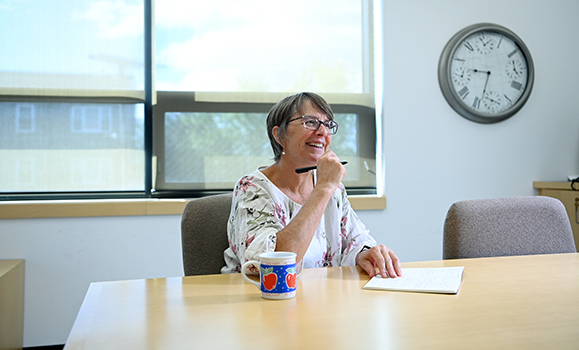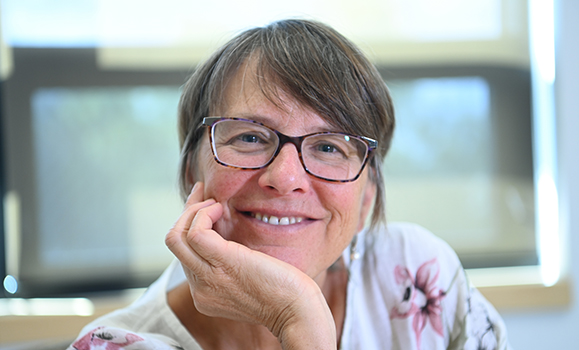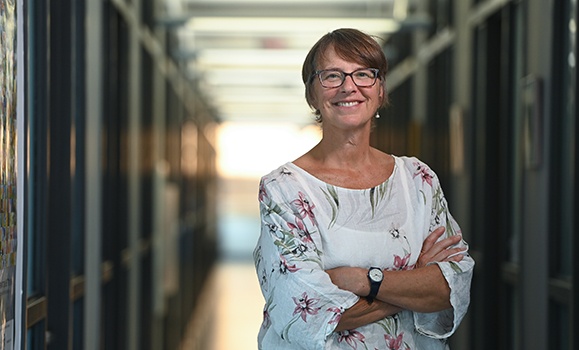Many health-care fields exist at the cutting edge of technology. Social work, by contrast, relies on one of the most old-fashioned tools of all: human connection.Ěý
"The primary tool we have is ourselves," says Dr. Marion Brown, a professor in and alum of Dalâs School of Social Work. "We take in information, we analyze it and figure it out, and then we are meant to be a resource to people and communities."
Though it may sound simple on the surface, building connection takes care. So does teaching students the awareness, analyses, and techniques they need to do so most effectively.Ěý
But Dr. Brown, who has been helping educate the next generation of social workers at Dal for more than 20 years, relishes the challenge. She says her enthusiasm for teaching has stayed consistent, even as the field itself has changed.Ěý
âThereâs something energizing for me in being with students and going into the classroom,â she says. âI can feel it rise up in me. I get excited."
Dr. Brown was rewarded for her energy and enthusiasm this year as the recipient of the Dalhousie Alumni Association Faculty Award of Excellence for Teaching, the universityâs top teaching award.Ěý
'Anything is possible'
Part of Dr. Brownâs success with students stems from her own efforts to put some of her fieldâs principles into practice in the classroom. Namely, building a learning environment that feels comfortable for sharing.
âThat is a process I spend a lot of time thinking about â how students can bring their full selves and experience their best learning in the classâ she says. âI think when we have that, anything is possible."

A typical first day in one of her courses begins with icebreakers where she and students get to know a bit about each other.Ěý
âI tend to say, in true Maritime fashion, âWeâre going to focus first on who we are and secondarily on what weâre doing here,â" she says. "It's not a big âWhy are you in social work?â discussion because people could feel, 'Oh itâs already an examination, I better have excellent things to say.'"
Empathy and understanding form a big part of her approach in the classroom.
Joanna Oginni, a Master of Social Work Student from Nigeria who was in one of Dr. Brownâs courses last year, recalls arriving late to class on the first day after hopping on the wrong bus by mistake.Ěý She worried what Dr. Brown would think.Ěý
Rather than being critical, Dr. Brown took the opposite approach.
âAfter the class, she called me and we spoke,â says Joanne. âI didnât feel judged, I didnât feel out of place, I didnât feel like she was being critical of me. Those were things that helped me settle into the class. It helped me to be calm.â
Another of Dr. Brownâs key priorities early each term revolves around setting up what she calls âcommunity commitments,â which are agreements about how people will engage with one another in class. These guidelines are determined by the whole class during a collective brainstorm, complete with flip chart and marker.
She says this process usually helps students feel equipped and empowered do their best learning â and unlearning.Ěý
From principles to practiceĚý
The latter, unlearning, can form a big part of the social work curriculum for some students, says Dr. Brown. She mentions the classic âgoing home for Thanksgivingâ moment where students in the first term of the undergraduate program report âsome uncomfortable conversations around the table.â
Dr. Brownâs own path to social work stretches back to childhood and high school when she started talking about wanting to work for childrenâs aid and help teens who were struggling. Part of this desire stemmed from an awareness of her own privilege, something she says she learned from her parents.Ěý
âPrivilege can be considered random, and yet itâs not, because my whiteness isnât random,â she says. âI had both gratitude for the comfort that I felt in my family and also a view of âWait a sec, why doesnât that kid who is also in my grade and at my school feel the same comfort that I do?â That doesnât seem fair.â
I love being part of that journey with students as they figure out how to say the things that might be useful to another person.
The flipside of comforting the afflicted is afflicting the comfortable through advocacy, she says. She tries to convey to students throughout their degrees that advocacy is part of a career in social work, even if it might not be an explicit component of their 9-5.Ěý
"As a social worker, we have to be paying attention to the world, to social context, and we have to play a role there," she says. "Social work is not a hat that you put on and take off during work hours because itâs grounded in values and principles and action."
It's this nexus between values, principles, theory, practice and advocacy that Dr. Brown finds most compelling as a teacher.Ěý
"I most enjoy teaching practice courses because this is where the students are taking all of what theyâve learned, all the concepts and histories and theories â theyâre holding all of that â and trying to figure out what to actually say."
She reinforces to students that having ideas and thinking about things is different than talking about them; that talking about ideas with colleagues and peers is different than bringing them to clients.
"Weâve got these big ideas and we need to convey them in the most accessible language," she says. "I love being part of that journey with students as they figure out how to say the things that might be useful to another person.â
 Ěý
Ěý

